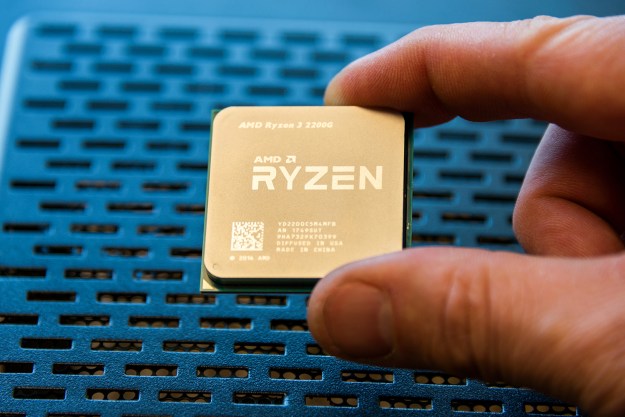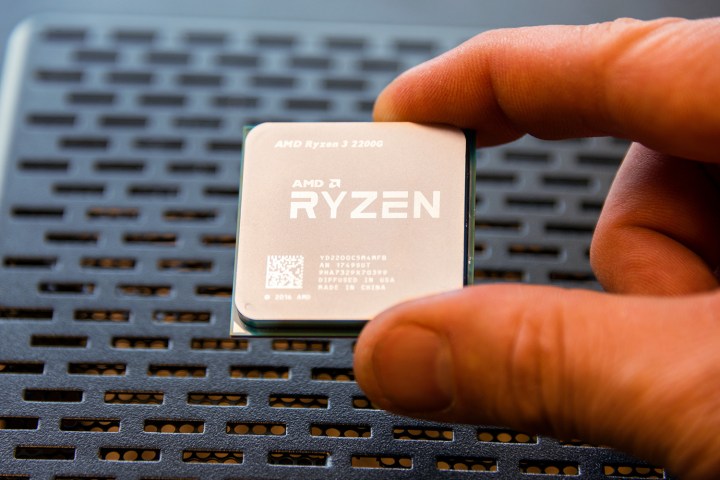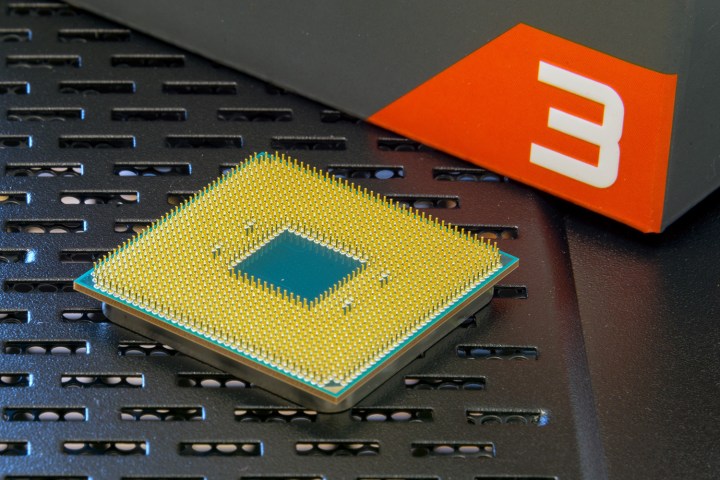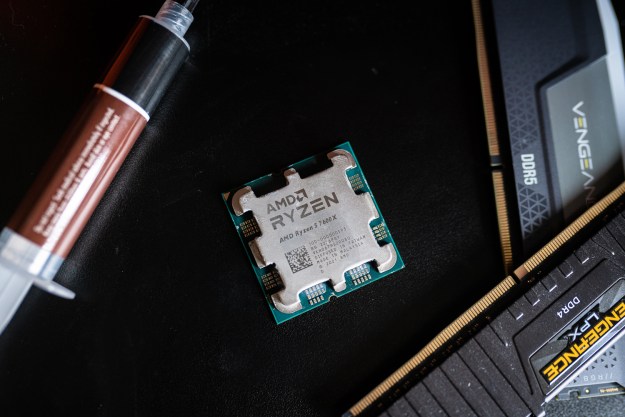
“The new Ryzen APUs outrun Intel integrated graphics, but that’s not saying much.”
- Affordable
- Decent gaming performance
- Onboard graphics are convenient for slim builds
- Modest processor performance
- Can handle only the least demanding games
Can you play PC games without a dedicated graphics card? AMD wants to suggest you can. It’s true that thousands of games on Steam or GOG have requirements low enough for even the most mild-mannered integrated graphics setup, but once even basic 3D graphics are added, performance can take a nose-dive. AMD’s latest processors aim to bridge the gap between expensive discrete GPU setups and inexpensive PCs running underpowered integrated graphics, and do it on a budget.
The new $169 Ryzen 5 2400G processor and its slimmed-down sibling, the $99 Ryzen 3 2200G, both feature onboard Vega graphics. AMD claims it’s powerful enough to run “esports games” and other less graphically demanding games. That’s a tall order for just a couple of budget processors, but if right, it’d given gamers an alternative to discrete cards that have recently skyrocketed in price. Let’s see if AMD can deliver.
What’s an APU?
These chips are a little different from your usual CPU. AMD calls the Ryzen 5 2400G and Ryzen 3 2200G an “APU,” which stands for accelerated processing unit. It’s AMD’s term for a processor with an integrated graphics chip. These new APUs feature graphics based on AMD’s proprietary Vega graphics architecture which, of course, is also found in the Radeon Vega 56 and 64 video cards.
It’s scaled back, of course. The Vega 56 and 64 derive their names from the number of “compute units” they have onboard – 56 and 64, respectively. The Ryzen 3 2200G has only eight compute units, and the Ryzen 5 2400G has 11. That’s a big cut from AMD’s high-end video cards, and it of course has serious consequences for performance.
Both processors work with the AM4 platform which debuted with the first Ryzen processors. Given that these new chips are budget models, we doubt anyone is going to “upgrade” to them. Still, the fact they work with that existing socket means there’s already many compatible motherboards available. Do remember that some might require a BIOS update, so be sure to double-check the compatibility, and your motherboard’s current BIOS version, before buying.
Intel is still in the fight
While the Vega is the headline feature of these APUs, they are still processors, and handle all the tasks you’d expect for a CPU. We’ve praised Ryzen in the past, noting its excellent multi-core performance for the price. Yet we also saw that Ryzen can’t keep up with Intel’s best in per-core performance metrics. Put another way, an Intel Core chip will generally outperform AMD’s Ryzen if both have the same core count and run at a similar clock speed.
The Ryzen 5 2400G and Ryzen 3 2200G don’t change the Ryzen architecture, so that rule stands. They’re simply outclassed in raw compute performance by less expensive processors. On Geekbench, the Ryzen 5 2400G kept pace with the Ryzen 3 1300X, but AMD’s own Ryzen 5 1600 and Intel’s Core i3-8100 both eclipsed the Ryzen 5 2400G’s performance. It’s an important point because the Ryzen 5 2400G is more expensive than the Ryzen 5 1600 and the Intel Core i3-8100, but it’s not as quick as either.
We saw similar results from the Ryzen 3 2200G, with single and multi-core performance falling below its closest competitors by a slim margin. Given the Ryzen 3 2200’s affordable price tag, just $100, it’s almost impressive. But the gap between it and a much more capable and performant processor like the Ryzen 5 1600, or Intel Core i3-8100, is too narrow to ignore. You’re only saving about $30 here. That’s not a lot even if you’re building a budget gaming rig.
They fall behind some of AMD’s own less-than-expensive offerings.
These results were reinforced in our 4K video encode test, with the Ryzen 5 2400G taking about 11 and a half minutes to finish an encode that took an i3-8100 processor only 11 minutes to finish. The Ryzen 5 1600 finished in just six minutes, thanks to its superior multi-core performance. The Ryzen 3 2200G finished the encode in about 12 minutes, again coming in well under its nearest competitors.
These results are mixed. Clearly, the Ryzen 5 2400G and Ryzen 3 2200G APUs are affordable processors with adequate performance for everyday. Yet, they fall behind some of AMD’s own less-than-expensive offerings like the Ryzen 5 1600, and the brand-new Intel Core i3-8100 — which retail for $189 and $130 respectively.
AMD’s APU tries to game, but falters
Okay, so the compute performance isn’t great. That might be alright if the Vega hardware can deliver. Graphical performance is supposed to be what sets the Ryzen APUs apart from typical CPUs. It’s what makes them a compelling alternative to other, more powerful — and less expensive — processors on the market. So, let’s have a look at how they do when they’re pushed to their limit.
Starting off with 3DMark, it’s clear that the APUs are not going to come anywhere close to the performance you’d get out of a discrete graphics card. Looking at the Nvidia GeForce GTX 1050, and the Radeon RX 560 — two solid entry-level options that are usually about $160 to $180 — the performance gap is clear. Even budget discrete GPUs like the RX 550 outperform the onboard graphics packed into the Ryzen 5 2400G and the Ryzen 3 2200G.
Moving on to some real-world testing in-game testing, the results are a bit mixed, but there’s still a discernible performance gap between a budget GPU and the built-in Vega graphics in the Ryzen 5 2400G and Ryzen 3 2200G.
Just paging through these graphs, you can see very clearly that the Ryzen 5 2400G and Ryzen 3 2200G are capable, but nowhere near as capable as the GTX 1050 or the slightly-higher-end Radeon RX 570. There’s just no contest. A discrete graphics card will beat out on-board graphics ten times out of ten, even if these new APUs come close in a few instances.
Looking at Rocket League, the Ryzen 5 2400G puts on a strong showing, hitting an average of 34 FPS with all the settings cranked up. That’s impressive for an onboard GPU. The Ryzen 3 2200G comes close, hitting a playable average of 29 FPS. They both outperform Intel’s UHD 620 onboard graphics by a fair margin, but let’s move on to a more demanding set of games.
Almost any discrete GPU will offer a massive performance bump over either APU.
Battlefield 1 really lays it all out for you. At medium settings, at 1080p, you’ll get about 22 FPS out of the Ryzen 5 2400G. It’s playable, if barely. But even a low-end graphics card like the GTX 1050 quadruples that score with ease.
We see that pattern over and over in Civilization VI at medium, and Ultra, and even in Deus Ex: Mankind Divided, which neither APU can run with anything approaching a playable framerate.
Just to see if they could handle it – as it’s not part of our usual test suite — we ran both APUs through Overwatch at Low-settings at 1080p. Surprisingly, both processors managed to hit playable framerates without any significant dips in performance. The Ryzen 5 2400G hit an average of 41 FPS, and the Ryzen 3 2200G hit an average of 26 FPS. Still, while these performance numbers are playable, they barely scrape by.
These new Ryzen APUs are the first with Vega, but they’re far from the first APUs from AMD. The company has tried for years to position its APUs as a bare-minimum gaming solution. They haven’t quite managed it, however, because they don’t truly offer the bare minimum. Most gamers will need more power than what the these APUs can offer. Yes, there are budget-strapped gamers who will buy this because they absolutely can’t afford anything else – but we doubt they will be happy about it.
Warranty
Both the Ryzen 5 2400G and Ryzen 3 2200G feature 3-year limited warranties covering manufacturer defects.
Our Take
Neither of AMD’s Ryzen chips completely lose the plot, but neither excels in any way. If you’re building a gaming PC from scratch, you’re only saving about $100 by picking an APU over a CPU and graphics card — and that doesn’t justify the dip in performance. Graphics cards have indeed become expensive thanks to cryptocurrency mining, but budget cards haven’t been impacted as severely or, in some cases, at all.
Is there a better alternative?
Yes, there are better alternatives. The tricky part here is pointing out which better alternative is the best choice. You could go with an Intel Core i3-8100, or a Ryzen 5 1600, and get better overall computing performance, but without a graphics card you wouldn’t be able to get much gaming done. That said, a GTX 1050 goes for about $160, so the price of two and a half games. And as you can see from our results, a GTX 1050 offers a massive performance bump over either the Ryzen 5 2400G or Ryzen 3 2200G.
How long will it last?
Unfortunately, not very long. Both the Ryzen 5 2400G and Ryzen 3 2200G are already outclassed by processors in their price range. Even their gaming performance won’t get you very far, with either of these processors you’re one game generation away from having to roll back your resolution to 720 or lower to get playable framerates out of them. They just don’t have the longevity of even a budget processor like the Ryzen 5 1600 or Intel Core i3-8100.
Should you buy it?
In most cases, you shouldn’t bother with either the Ryzen 5 2400G or the Ryzen 3 2200G — just buy the Ryzen 5 1600 or Intel Core i3-8100 and pair them with a discrete graphics card. The Ryzen APUs are the option of last resort for budget gaming and, should you find yourself putting together a rig for $400, we’re sure you’ll appreciate them. If you game enough to identify yourself as a gamer, though, you likely won’t be pleased with the performance the Ryzen 5 2400G and 2200G muster.
Editors' Recommendations
- I’ve reviewed every AMD and Nvidia GPU this generation — here’s how the two companies stack up
- Nice try, Intel, but AMD 3D V-Cache chips still win
- AMD vs. Intel: the rivalry has never been more fierce
- The best processors in 2024: AMD and Intel CPUs duke it out
- AMD’s new CPU slammed as ‘anti-consumer at best’





